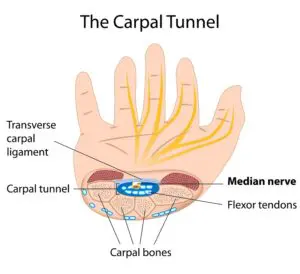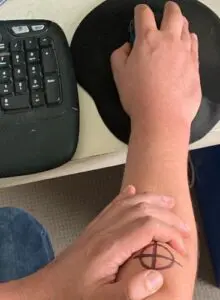Thoracic Outlet Syndrome occurs when nerves and/or blood vessels in the neck and shoulder area become compressed. It is the third most common nerve entrapment after carpal tunnel and cubital tunnel syndrome.
In Brisbane, Knead Massage offer Expert Myotherapy treatments for Thoracic Outlet Syndrome. A Myotherapist will diagnose and remedy restrictions in the nerves and vascular structures responsible for numbness, tingling and weakness in your hands, arms and fingers.
Studies estimate that up to 8% of the population suffer from Thoracic Outlet Syndrome at any given time. Thoracic outlet syndrome is frequently mislabelled Carpal Tunnel Syndrome. Which is a shame, since injecting cortisone into the carpal tunnel of someone with Thoracic Outlet restrictions is ineffective. Carpal Tunnel Syndrome and Thoracic Outlet Syndrome frequently occur together – treating one without the other means that the symptoms are unlikely to disappear.
This article discusses:
- what to do if you have recurring numbness and weakness in your fingers and hands.
- The methods a Clinical Myotherapist will use to resolve your symptoms quickly
- How to prevent future episodes of thoracic outlet syndrome
We will also discuss the three types of Thoracic Outlet Syndrome (TOS):
- Neurogenic TOS occurs when the nerves of the thoracic outlet become compressed. Resulting in sensations such as weakness, pain, and tingling in the arm and hand.
- Arterial TOS occurs when the arteries that pass through the thoracic outlet become compressed or pinched, causing reduced blood flow to the arm and hand resulting in coldness, weakness and loss of sensation/numbness.
- Venous TOS occurs when the veins that pass through the thoracic outlet become compressed or pinched, causing swelling, pain, and in extreme cases blood clots in the arm and hand.
Break free from the grip of thoracic outlet syndrome?
What’s Thoracic Outlet Syndrome?
Thoracic Outlet Syndrome is a collective term for a group of symptoms that occur when neurovascular structures get compressed as they pass through the thoracic outlet (the space between your collarbone and the first rib).
This can cause:
- shoulder and neck pain
- Changes to the skin colour of your hands
- numbness in your fingers.
- Weakness in the grip
- Shooting/electrical pain in the hands
- Inability to raise your arms over your shoulder
There are three sites where nerves and blood vessels can be compressed as they transit from the neck to the armpit and upper arm:
- Most commonly, neural and vascular entrapment happens in interscalene triangle – between the first rib and scalene muscles.
- The second space is the costoclavicular triangle – the area between the clavicle and first rib.
- The third site of compression is just under the pectoralis minor tendon and is called the subcoracoid space.

What Causes Thoracic Outlet Syndrome?
TOS can be caused by a variety of factors:- physical injury and trauma trauma
- repetitive strain of the neck and poor posture (poke chin posture, rounded shoulder)
- repetitive arm or shoulder motions (repetitive strain usually combined with poor posture)
- anatomical abnormalities (Spinal stenosis, spondylosis, severe hyper-kyphosis and scoliosis).
- Idiopathic (Sometimes the causes are unknown.)
- Tumours or enlarged lymph nodes in the upper chest or underarm.
- Stress or depression
What are the Symptoms of Thoracic Outlet Syndrome?
Depending on the type the symptoms can vary. With neurogenic TOS, you may have such symptoms as:
- Ache in the neck, shoulder, arm or hand
- Numbness or/and tingling in your arm or fingers
- Muscles weakness, especially with grip
- Possible muscle atrophy in the thumb
Common symptoms of vascular TOS include:
- Hand or arm pain and swelling, possibly due to blood clots
- Pale (pallor) or bluish colour (cyanosis) of the fingers or hand
- Arm weakness and fatigue after activity
- Cold fingers, hands or arms
- Weak or absent pulse in the affected arm
- Throbbing lump near the collarbone
How to Fix Thoracic Outlet Syndrome?
Treatment for TOS usually involves manual therapy, exercise solutions and pain relief medications. Treatment for vascular TOS may also include thrombolytic (clot-busting) or anticoagulant (blood thinning) medications. Most people improve with these treatments. In more severe cases, however, especially caused by anatomical defects or trauma, your doctor may recommend surgery.
Myotherapy Treatment for Thoracic Outlet
Myotherapy treatment for Thoracic Outlet Syndrome may include:
At Knead Massage and Myotherapy, our Clinical Myotherapists will perform a thorough physical examination, including posture, movement, orthopaedic testing and nerve assessment to determine causes and possible complications of your symptoms.
- Soft tissue release to decrease nerve compression (reduce tingling and improve blood flow)
- Myofascial dry needling (to reduce muscle and joint restriction) and electrotherapy (to reduce neural inflammation and reduce tingling)
- Low level laser therapy for swelling and pain
- Nerve mobilisation, glides and sliders (restore overhead movements and reduce tingling/numbness)
- Expert Joint Mobilisations (mobilising the 1st rib and clavicle as well as c5-t5 can greatly reduce nerve restriction)
- Postural awareness intervention – targeted exercises that allow you to overcome your pain at home (strengthening the relationship between the brain and the muscle that position the head and shoulders – improving your dynamic sitting posture)
How to Massage Thoracic Outlet Syndrome?
Effectively massaging the Thoracic Outlet and the muscles and nerves of the front neck requires precision and a high level of anatomical knowledge. At Knead Myotherapy our unique side lying Scalene release – aggressively targets these muscles – but we also incorporate MANY sophisticated nerve sliders and mobilisations at the same time – delivering rapid results. Our expert Myotherapists are degree qualified with many years of experience delivering first class outcomes for people with neck and shoulder disorders and nerve dysfunctions. Reducing the tone of the 3 scalene muscles and the SCM(sternocleidomastoid) is absolutely one of the most effective ways to reduce restriction of the brachial plexus and the vascular structures of the Thoracic Outlet.
Thoracic Outlet Syndrome and Carpal Tunnel:
A high percentage of people who are labelled Carpal Tunnel Syndrome – actually have Thoracic Outlet Syndrome or a combination of the two. True Carpal Tunnel Syndrome is a swelling of tendons at the wrist which restricts the median nerve at the carpal tunnel (the wrist) causing symptoms into the palmar surface of the hand and the thumb and first two digits. Its seldom this neat, but that’s a true carpal tunnel nerve referral. However, many people who present with “Carpal Tunnel” often present with neck pain and restriction at the shoulder and front of the shoulder (the thoracic outlet area) with nerve symptoms referring down the bicep or tricep into the forearm and then the hand. These people may have a double crush or even a triple crush nerve restriction – the restriction happens at
- The rear neck and shoulder
- The front of the shoulder (thoracic outlet)
- In the front of the arm (the median nerve as it exits the shoulder)
- In the forearm
- In the wrist (carpal tunnel)
These individuals have nerve restriction all the way along the nerve pathway and actually present with far more Thoracic Outlet restriction than Carpal Tunnel Syndrome.
A 60 minute Myotherapy treatment treating the entire nerve pathway may deliver more benefits than weeks of treatment with other clinicians. See for yourself.
Related Posts

Neck Pain Brisbane

Carpal Tunnel Treatment Brisbane

Arm Pain Brisbane
Frequently Asked Questions (FAQs)
Thoracic Outlet Syndrome can mimic other medical conditions. Some disorders, like neck arthritis, nerve impingement, or carpal tunnel , may cause similar symptoms to neurogenic TOS, such as shooting pain or tingling in the hands. Other conditions like a damaged rotator cuff, fibromyalgia, and multiple sclerosis can cause pain and numbness in your shoulders and arms.
Common causes of Thoracic Outlet Syndrome include:
- anatomical defects that reduce the space between your collarbone and the rib cage, compressing neurovascular structures
- physical injury, such as a car accident, etc
- poor posture
- Overuse from daily or sports related activities
- Tumour
- Stress or depression
There are three known types of Thoracic Outlet Syndrome:
- Neurogenic TOS
Venous TOS
Arterial TOS

Liza Markova








Latest posts by Liza Markova (see all)
- Frozen Shoulder Brisbane - September 13th, 2023
- Thoracic Outlet Syndrome Brisbane - September 27th, 2022
- SIJ Pain Brisbane - February 4th, 2022

